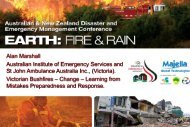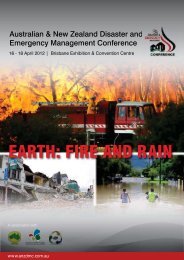Book of Abstracts 2013 - Australian and New Zealand Disaster ...
Book of Abstracts 2013 - Australian and New Zealand Disaster ...
Book of Abstracts 2013 - Australian and New Zealand Disaster ...
Create successful ePaper yourself
Turn your PDF publications into a flip-book with our unique Google optimized e-Paper software.
natural catastrophe? The discussion is situated within, <strong>and</strong> contributes to, debates on international good practice for<br />
disaster response. Findings support a continued effort to promote community engagement in disaster preparedness<br />
<strong>and</strong> response strategies, <strong>and</strong> to protect existing local coping mechanisms <strong>and</strong> nurture resilience. This is apposite as<br />
international (eg. UNISDR, Hyogo) <strong>and</strong> <strong>Australian</strong> (National <strong>Disaster</strong> Resilience Framework 2011) continue to increase<br />
their focus on community engagement <strong>and</strong> resilience. <strong>Disaster</strong> management agencies need to identify strategies that<br />
better support, rather than hinder, the kind <strong>of</strong> spontaneous community galvanization (<strong>and</strong> uniquely Burmese “culture<br />
<strong>of</strong> sharing”) that led to a surprisingly successful local response to Cyclone Nargis in Myanmar. The paper identifies<br />
policy <strong>and</strong> practice implications for international <strong>and</strong> domestic disaster responses.<br />
Ms Doerte Jakob<br />
Manager Hydrometeorological Advisory Services, Bureau <strong>of</strong> Meteorology<br />
Co Authors - Dr David Wall<strong>and</strong>, Head Climate Services, Bureau <strong>of</strong> Meteorology. Dr David Jones, Manager Climate<br />
Monitoring <strong>and</strong> Prediction, Bureau <strong>of</strong> Meteorology.<br />
Variability <strong>and</strong> trends in temperature <strong>and</strong> precipitation extremes<br />
The severe flooding <strong>and</strong> bushfires in recent months have been a pertinent reminder <strong>of</strong> the risks our society faces from<br />
extreme weather events. The Bureau <strong>of</strong> Meteorology provides information about the risks <strong>of</strong> extreme heat or rainfall<br />
occurring, based on historical occurrence as well as short range weather forecasts. These climatological risks can be<br />
specified in terms <strong>of</strong> Annual Exceedance Probability or Average Recurrence Intervals. Conventional definitions <strong>of</strong> risk<br />
are based on the notion that the likelihood <strong>of</strong> extremes does not change over time. However, in the presence <strong>of</strong> modes<br />
<strong>of</strong> climate variability - such as the El Niño Southern Oscillation (ENSO) - <strong>and</strong> climate change this assumption <strong>of</strong><br />
stationarity is no longer valid. Our analysis <strong>of</strong> trends <strong>and</strong> variability <strong>of</strong> extremes in temperature (maximum <strong>and</strong><br />
minimum) <strong>and</strong> precipitation is based on a recently completed high-quality dataset. We have used extreme value<br />
distributions to assess trends over the period 1910 to 2009 <strong>and</strong> to explore the effects <strong>of</strong> ENSO on temperature <strong>and</strong><br />
rainfall extremes. Similar analyses could be applied to other sector-relevant variables <strong>and</strong> indices. Our key findings can<br />
be summarised as follows: - To avoid spurious identification <strong>of</strong> trends in extremes, the analyses have to be based on<br />
homogenised data. - Depending on the variable, the effects <strong>of</strong> ENSO can be <strong>of</strong> a similar magnitude as long-term changes<br />
in extremes <strong>and</strong> climate change may lead to an intensification <strong>of</strong> heat extremes under El Niño. - There is a general<br />
tendency for shortened return periods when analysing high maximum temperatures but with significant regional<br />
deviations from this pattern. Causes for these regional variations are still under investigation. - Trends in low minimum<br />
temperatures are typically stronger than in high maximum temperatures. We will discuss a state-<strong>of</strong>-the-art approach to<br />
model the time-dependence <strong>of</strong> risks by combining information at a regional scale.<br />
Mr Valdis Juskevics<br />
Social <strong>and</strong> Economic Statistician, Geoscience Australia<br />
Co Author - Ms Shelby Canterford, Demographer, Geoscience Australia<br />
The January 2011 Brisbane Floods: Recovery <strong>and</strong> Resilience<br />
More than 17,000 dwellings in the Brisbane <strong>and</strong> Ipswich area were flood affected when the Bremer <strong>and</strong> Brisbane<br />
Rivers exceeded major flood levels in January 2011. Significant damage was caused to property <strong>and</strong> many households<br />
were severely disrupted for extended periods <strong>of</strong> time. The disaster prompted a large effort <strong>and</strong> a range <strong>of</strong> provisions to<br />
enable the clean-up <strong>of</strong> the direct damage <strong>and</strong> the promotion <strong>of</strong> recovery. The disaster provided a valuable opportunity<br />
to examine the community recovery following the event <strong>and</strong> to consequently obtain a better underst<strong>and</strong>ing <strong>of</strong> the<br />
resilience <strong>of</strong> <strong>Australian</strong> households to flood. During April <strong>and</strong> May 2012 Geoscience Australia, in collaboration with the<br />
<strong>New</strong> Zeal<strong>and</strong> National Institute for Water <strong>and</strong> Atmospheric Research, conducted a postal survey <strong>of</strong> residents in the






